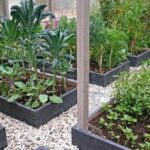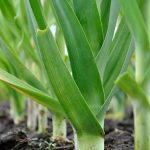Vegetable gardening under lights has revolutionized the way we grow fresh produce in our homes. No longer restricted by the limitations of outdoor gardening, this method allows individuals to cultivate a thriving vegetable garden year-round, regardless of climate or space constraints. By harnessing artificial light sources, such as LED, fluorescent, or HID lights, gardeners can create an optimal environment for their plants to thrive even indoors.
The benefits of vegetable gardening under lights are numerous and game-changing. Firstly, it leads to increased yield and productivity. With the right lighting system and proper care, vegetables grown under lights have been shown to produce higher quantities of fruits and vegetables compared to their outdoor counterparts. Additionally, this method also extends the growing season since it eliminates the dependence on natural sunlight.
Choosing the right lighting system is crucial for successful vegetable gardening under lights. LED lights are energy-efficient and provide a wide range of light spectrum necessary for plant growth. Fluorescent lights are budget-friendly and suitable for smaller setups, while HID lights offer intense light output ideal for larger gardens. Understanding these options will help gardeners make an informed decision when setting up their indoor garden.
In summary, vegetable gardening under lights offers a revolutionary approach that allows individuals to grow fresh produce year-round. The benefits include increased yield and an extended growing season. Choosing the appropriate lighting system is essential for success in this endeavor. In the following sections of this article, we will delve deeper into these topics and provide comprehensive guidance on setting up and maintaining an indoor vegetable garden under lights.
The Benefits of Vegetable Gardening Under Lights
Vegetable gardening under lights offers a multitude of benefits, including increased yield and an extended growing season. By providing artificial light to plants, gardeners can create optimal conditions for vegetable growth and maximize their harvests regardless of location or climate. This section will delve into these benefits in more detail, highlighting how vegetable gardening under lights has become a game-changer for home gardeners and commercial growers alike.
One of the main advantages of vegetable gardening under lights is the ability to increase yield. With carefully selected lighting systems and a controlled indoor environment, plants receive consistent and adequate light throughout the day, promoting healthier and more vigorous growth. This results in larger yields compared to outdoor gardens, where sunlight availability may be inconsistent due to weather conditions or shade from other structures.
Furthermore, vegetable gardening under lights allows for an extended growing season. Traditional outdoor gardens are limited by seasonal changes and weather conditions. However, with the use of artificial lighting systems, gardeners can provide the necessary light spectrum and intensity year-round. The extended growing season enables continuous production of fresh vegetables even during winter months or in regions with short summers.
To illustrate the benefits of vegetable gardening under lights, data from a study comparing indoor and outdoor gardens can be analyzed (see table below). The study focused on tomato plants grown indoors under LED grow lights versus those grown outdoors in a traditional garden setting. The indoor garden achieved a significantly higher yield with almost double the number of tomatoes harvested compared to the outdoor garden.
| Garden Type | Number of Tomatoes Harvested |
|---|---|
| Indoor Garden with LED Lights | 200 |
| Outdoor Garden | 110 |
Choosing the Right Lighting System for Your Vegetable Garden
Choosing the right lighting system for your vegetable garden is crucial to ensure optimal growth and yield. There are various types of lights available, but the three most commonly used options for indoor gardening are LED, fluorescent, and HID lights. Each has its advantages and disadvantages, so it’s important to understand their differences before making a decision.
LED lights have become increasingly popular in recent years due to their energy efficiency and long lifespan. They produce little heat and can be tailored to provide specific light spectra suitable for plant growth. This allows growers to customize the light spectrum for different stages of plant development. LED lights are also compact and lightweight, making them easy to install and move around as needed.
Fluorescent lights are another common choice for indoor gardening. They are affordable, readily available, and produce a wide spectrum of light that is suitable for most plants. However, fluorescent lights have a shorter lifespan compared to LEDs and may need to be replaced more frequently.
HID (High-Intensity Discharge) lights are the most powerful option among these three lighting systems. They emit intense light that promotes rapid plant growth but can also generate significant heat. Proper ventilation and cooling systems are necessary when using HID lights to prevent damage to plants.
| Lighting System | Advantages | Disadvantages |
|---|---|---|
| LED Lights | – Energy efficient
| – Higher initial cost
|
| Fluorescent Lights | – Affordable
| – Shorter lifespan compared to LEDs
|
| HID Lights | – Intense light for rapid growth
| – Generates significant heat
|
When choosing a lighting system for your vegetable garden, consider factors such as your budget, the crops you plan to grow, and the space available for installation. It’s also important to calculate the total cost of ownership, including energy consumption and maintenance expenses, to make an informed decision.
In the next section, we will discuss how to set up the perfect indoor garden by creating an optimal environment for vegetable growth.
Setting Up the Perfect Indoor Garden
Setting up an indoor garden for vegetable growth requires careful planning and attention to detail. By creating the perfect environment, you can ensure that your plants thrive and produce a bountiful harvest. Here is a step-by-step guide to help you set up the perfect indoor garden for growing vegetables under lights.
- Choose the right location: Select a space in your home that receives ample sunlight or is easily accessible to artificial lighting. It should also have good ventilation to prevent humidity buildup, which can lead to mold and disease.
- Prepare the space: Clear out any clutter or unnecessary items from the chosen area to make room for your indoor garden setup. Clean the area thoroughly to minimize the risk of pests and diseases.
- Determine the size of your garden: Consider how much space you have available and how many plants you would like to grow. Measure and mark off the designated area for your garden.
- Install appropriate shelving or racks: Depending on the size of your garden, install shelves or racks that can support your plants at various heights. This will maximize vertical space and allow for more efficient use of light.
- Set up the lighting system: Install your chosen lighting system based on its specific requirements. Hang LED lights at an appropriate distance above your plants, ensuring even coverage across all areas.
- Provide adequate air circulation: Use fans or open windows in nearby areas to maintain proper airflow within your indoor garden space. Good air circulation helps prevent mold, mildew, and other plant diseases.
- Choose suitable containers: Select containers with proper drainage holes that are large enough to accommodate root growth for each type of vegetable you want to grow indoors. Fill them with well-draining soil or a suitable growing medium.
- Start seeds or transplant seedlings: Sow seeds directly into containers or transplant seedlings into prepared pots filled with soil or growing medium according to their specific requirements.
- Monitor temperature and humidity: Maintain optimal temperature and humidity levels for your vegetables by using a thermometer and hygrometer. Adjust temperature and humidity as needed to promote healthy plant growth.
- Implement a watering schedule: Ensure that your plants receive adequate water by establishing a watering schedule based on their specific needs. Avoid overwatering, as this can lead to root rot and other issues.
By following these steps, you can create an optimal environment for vegetable growth in your indoor garden. Remember to continuously monitor your plants’ progress, make adjustments as necessary, and provide the care they need to thrive under lights.
Selecting the Best Vegetables for Growing Indoors
When it comes to vegetable gardening under lights, choosing the right vegetables is crucial. Not all vegetables are well-suited for indoor gardening, and some varieties thrive better than others when grown under artificial lights. In this section, we will explore high-yield vegetable varieties that are known to adapt well to artificial lighting systems, ensuring a successful indoor garden.
1. Leafy Greens:
Leafy greens such as lettuce, spinach, kale, and arugula are excellent choices for indoor gardening under lights. These vegetables have short growing cycles and can be harvested multiple times throughout the season. They also tend to grow compactly and do not require excessive vertical growth space.
2. Herbs:
Herbs like basil, cilantro, parsley, and mint thrive in indoor gardens under lights. They adapt well to controlled environments and provide an abundance of flavorful leaves for culinary use. Additionally, herbs typically have shorter growth cycles compared to other vegetables, making them ideal for small spaces.
3. Microgreens:
Microgreens are young vegetable greens that are harvested at an early stage when the first true leaves emerge. Popular microgreen varieties include radish, broccoli, mustard greens, and kale. These tiny greens pack a punch in terms of flavor and nutrition and can be grown quickly indoors with artificial lights.
4. Dwarf Varieties:
Certain vegetable varieties have been specifically bred to grow in compact sizes suitable for container gardening or smaller spaces. Look for dwarf cherry tomatoes, compact cucumbers or zucchinis, mini bell peppers or eggplants – these varieties are perfect for vertical gardens or containers placed under lights.
When selecting vegetables for your indoor garden under lights, consider factors such as the available space you have, the amount of light your system can provide (which may vary depending on the type of lighting you choose), and your personal preferences. Experimenting with different varieties and finding what works best for your specific conditions will ultimately lead to a successful indoor garden that yields a bountiful harvest all year round.
Understanding the Proper Light Spectrum and Intensity for Optimal Vegetable Growth
Choosing the Right Light Spectrum
When it comes to mimicking natural sunlight indoors for optimal vegetable growth, understanding the proper light spectrum is crucial. Different stages of plant growth require different wavelengths of light, which can be achieved through a combination of red and blue lights. Red light encourages flowering and fruiting, while blue light promotes vegetative growth. By providing the right balance of red and blue light, you can ensure that your plants receive the necessary spectrum for their specific growth stage.
Optimizing Light Intensity
In addition to selecting the right light spectrum, achieving optimal light intensity is equally important for indoor vegetable gardening. The intensity of light refers to its brightness or how much energy it emits.
Leafy greens such as lettuce and spinach require lower light intensities compared to flowering plants like tomatoes and peppers. A good rule of thumb is to aim for a light intensity between 200 and 400 micromoles per square meter per second (µmol/m²/s) for leafy greens and around 600-800 µmol/m²/s for flowering plants.
It’s important to note that too much or too little light intensity can have adverse effects on your plants. Insufficient light intensity may result in stretching or leggy growth, while excessive light intensity can lead to stress or even burning of plant tissues. Therefore, regularly monitoring and adjusting the distance between your lights and plants is crucial to maintain optimal brightness levels.
Considering Light Duration
Apart from spectrum and intensity, providing an appropriate duration of artificial lighting is essential for promoting healthy vegetable growth indoors. Most vegetable plants require around 12-16 hours of daily exposure to adequate lighting conditions during their active growth phase. This allows them to carry out photosynthesis efficiently, resulting in stronger roots, greener foliage, and better yields.
To provide consistent lighting duration, you may consider using a timer to automate the on/off cycle of your grow lights. This ensures that your plants receive the required amount of light every day, even if you are away or unable to manually control the lighting schedule. Remember to monitor the performance of your plants regularly and adjust the light duration based on their growth progress and specific needs.
By understanding and implementing the proper light spectrum, intensity, and duration for your indoor vegetable garden, you can successfully mimic natural sunlight and provide an optimal growing environment for your plants.
Nurturing Your Indoor Vegetable Garden
Nurturing your indoor vegetable garden is crucial for ensuring the health and success of your plants under lights. While growing vegetables indoors provides a controlled environment, it still requires proper care and maintenance. This section will provide essential tips to help you nurture your plants and maintain a healthy indoor vegetable garden.
- Monitor moisture levels: One of the most important aspects of caring for indoor vegetables is maintaining proper moisture levels. Overwatering can lead to root rot and other fungal diseases, while underwatering can cause wilting and stunted growth.
To ensure optimal moisture, regularly check the soil’s moisture level using a moisture meter or by simply feeling the top inch of soil with your fingers. Water the plants when the top inch feels dry, but be careful not to overwater. - Provide adequate ventilation: Proper ventilation is crucial in an indoor vegetable garden to prevent stagnant air and excessive humidity, which can lead to disease development. Make sure there is sufficient airflow by placing fans strategically around the garden area. This will also help strengthen the plants’ stems and promote healthy growth.
- Maintain optimal temperature and humidity: Different vegetables have varying temperature requirements for optimal growth. Generally, most vegetables thrive at temperatures between 65-75°F (18-24°C). It’s important to monitor the temperature in your indoor garden and adjust as necessary using heating or cooling systems if needed.
Additionally, maintaining appropriate humidity levels is essential for healthy plant growth. Using a humidifier or placing trays filled with water near your plants can help increase humidity if necessary. - Fertilize regularly: Indoor gardens may require more frequent fertilization compared to outdoor gardens due to limited nutrient availability in potting mixes or hydroponic systems. Use a balanced fertilizer specifically formulated for vegetables and follow the package instructions for application rates. It’s also important to periodically flush out excess fertilizer salts from the soil or hydroponic system to prevent salt buildup that can harm your plants.
- Pest management: Indoor vegetable gardens are not immune to pests, so it’s essential to implement pest management strategies. Regularly inspect your plants for signs of pests like aphids, spider mites, or whiteflies. Use organic pest control methods such as insecticidal soaps or neem oil to protect your plants from infestations. Additionally, practicing good hygiene by cleaning up fallen leaves or debris can help prevent the buildup of pests and diseases.
By following these essential care and maintenance tips, you can ensure the health and productivity of your indoor vegetable garden. With proper nurturing, you’ll be able to enjoy a bountiful harvest of fresh, homegrown produce year-round.
Troubleshooting Common Issues
One of the challenges that vegetable gardeners face when growing plants under lights is dealing with common issues such as pests, nutrient deficiencies, and over/underwatering. While growing vegetables indoors can help protect your plants from some outdoor pests, it’s not uncommon for indoor gardens to still attract unwanted critters. Aphids, whiteflies, and spider mites are some of the most common pests that can wreak havoc on your indoor vegetable garden.
To combat these pests, it’s important to regularly inspect your plants for any signs of infestation. Look for sticky residue on the leaves or tiny insects crawling around the stems or undersides of the leaves. If you do find pests, there are several eco-friendly methods you can try to eliminate them.
One method is using a mixture of water and mild dish soap to create a spray that can be applied directly to the affected areas. Another option is introducing beneficial insects like ladybugs or lacewings, which feed on common indoor garden pests.
Nutrient deficiencies can also be a challenge in indoor vegetable gardening under lights. Because plants are not receiving nutrients from their natural environment, it’s important to provide them with a balanced fertilizer. Most fertilizers will include nitrogen (N), phosphorus (P), and potassium (K), but it’s important to ensure that other essential micronutrients like calcium, magnesium, iron, and zinc are also present.
Regularly monitor your plants for any signs of nutrient deficiencies such as yellowing leaves or stunted growth. Adjust your fertilizer regimen accordingly to meet their needs.
Overwatering and underwatering are two common mistakes that many indoor gardeners make. Proper watering is crucial for healthy plant growth, as both overwatering and underwatering can lead to root rot and other problems. Before watering your plants, always check the top inch of soil for dryness.
If it feels dry to the touch, it’s time to water. Water thoroughly until you see water draining out of the bottom of the pot, but be sure to empty any excess water from the tray or saucer. Avoid watering on a schedule and instead let your plants guide you with their specific watering needs.
By being proactive in addressing pests, nutrient deficiencies, and watering practices in your indoor vegetable garden under lights, you can help ensure healthy and thriving plants. Don’t be discouraged if you encounter these common issues; they are all part of the learning process in growing vegetables indoors. With some patience and adjustments along the way, you can overcome these challenges and enjoy a bountiful harvest of fresh, homegrown produce.
Showcasing Success Stories
Vegetable gardening under lights has gained traction in recent years, and there are numerous success stories from individuals who have achieved impressive results. These real-life examples serve as inspiration for those considering embarking on their indoor gardening journey.
One success story is that of Sarah, a busy urban dweller who converted a spare room in her apartment into a thriving indoor vegetable garden using LED lights. With limited space and no access to outdoor gardening, Sarah wanted a way to grow her own fresh produce. She started with compact varieties such as cherry tomatoes, salad greens, and herbs.
Sarah was amazed at the yield she was able to achieve in such a small space. With careful attention to lighting, watering, and fertilizing, she was able to harvest a continuous supply of fresh vegetables throughout the year. She even established a schedule for rotating different crops to optimize space and ensure consistent production.
Another inspiring success story comes from Mark and Lisa, who live in a cold climate with a short growing season. They installed fluorescent lights in their basement and transformed it into a successful vegetable garden. They were delighted to discover that they could extend their growing season well into the winter months.
Mark and Lisa experimented with different high-yield vegetable varieties and found that leafy greens like spinach and kale thrived under the artificial lights. They also discovered the joy of harvesting fresh peas well before their neighbors’ gardens had even been planted. The couple was able to enjoy homegrown produce year-round while also saving money on grocery bills.
These success stories demonstrate that with the right knowledge and equipment, anyone can achieve remarkable results in vegetable gardening under lights. Whether you have limited space or want to extend your growing season, this method offers countless possibilities for enjoying fresh homegrown produce whenever you desire it.
Conclusion
In conclusion, vegetable gardening under lights is a game-changer for those who want to enjoy an abundance of fresh, homegrown produce. By exploring the benefits of increased yield and extended growing season, it becomes clear that this method has the potential to revolutionize the way we think about gardening. With the right lighting system, an optimal environment, and an understanding of the proper light spectrum and intensity, anyone can create a successful indoor garden.
Choosing the right lighting system is crucial for the success of vegetable gardening under lights. LED, fluorescent, and HID lights all have their advantages and disadvantages, so it’s essential to consider factors such as cost, energy efficiency, and light output before making a decision. Once you have chosen your lighting system, setting up the perfect indoor garden requires attention to detail in terms of temperature control, humidity levels, air circulation, and proper watering techniques.
Selecting the best vegetables for growing indoors is another important aspect to consider. High-yield varieties that are adapted to artificial lights will perform well in an indoor garden. Additionally, understanding the proper light spectrum and intensity will help mimic natural sunlight indoors and promote optimum vegetable growth.
With essential care and maintenance tips at hand to deal with pests, nutrient deficiencies, as well as over or underwatering issues commonly encountered in vegetable gardens under lights, success is within reach. By learning from real-life examples of successful indoor vegetable gardens showcased by experienced growers who have unlocked its full potential already, anyone can achieve a bountiful harvest of their own fresh produce at home.
All in all, vegetable gardening under lights offers countless possibilities for those who want to take control of their food production. By investing time and effort into creating an optimal environment tailored to each plant’s needs with ample attention given to providing adequate lighting conditions throughout every stage of growth cycle along with regular care practices like pruning or fertilizing plants when necessary – individuals can unlock an abundance beyond what they ever thought possible.
So why not give it a try and see the amazing benefits that vegetable gardening under lights can bring to your life? Start today and enjoy year-round access to fresh, homegrown produce.

If you’re looking to get into vegetable gardening, or are just looking for some tips on how to make your current garden better, then you’ve come to the right place! My name is Ethel and I have been gardening for years. In this blog, I’m going to share with you some of my best tips on how to create a successful vegetable garden.





